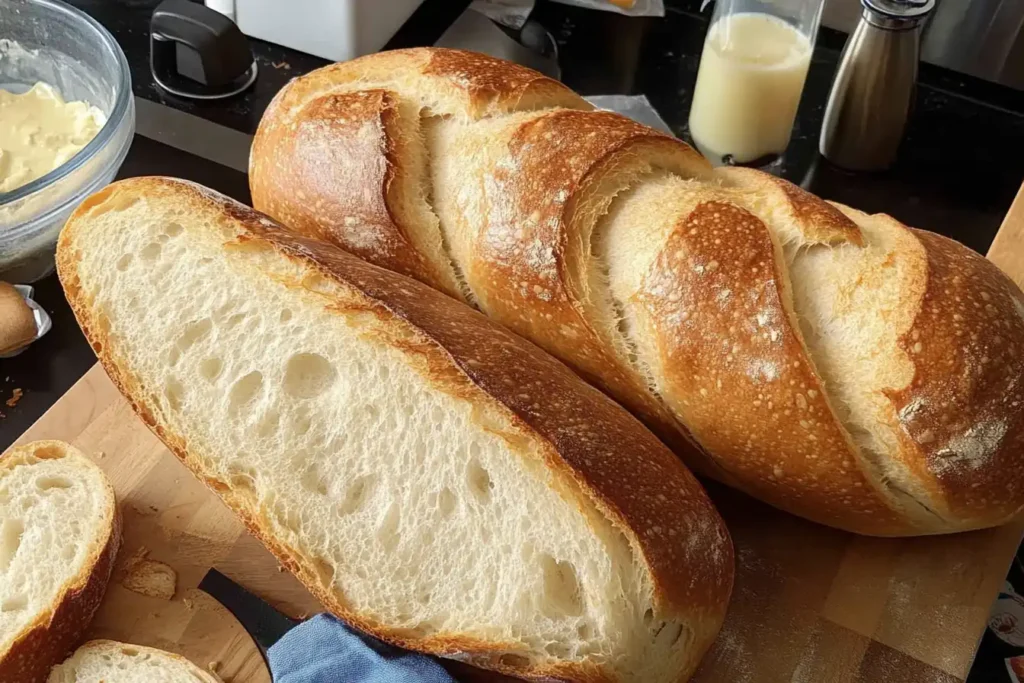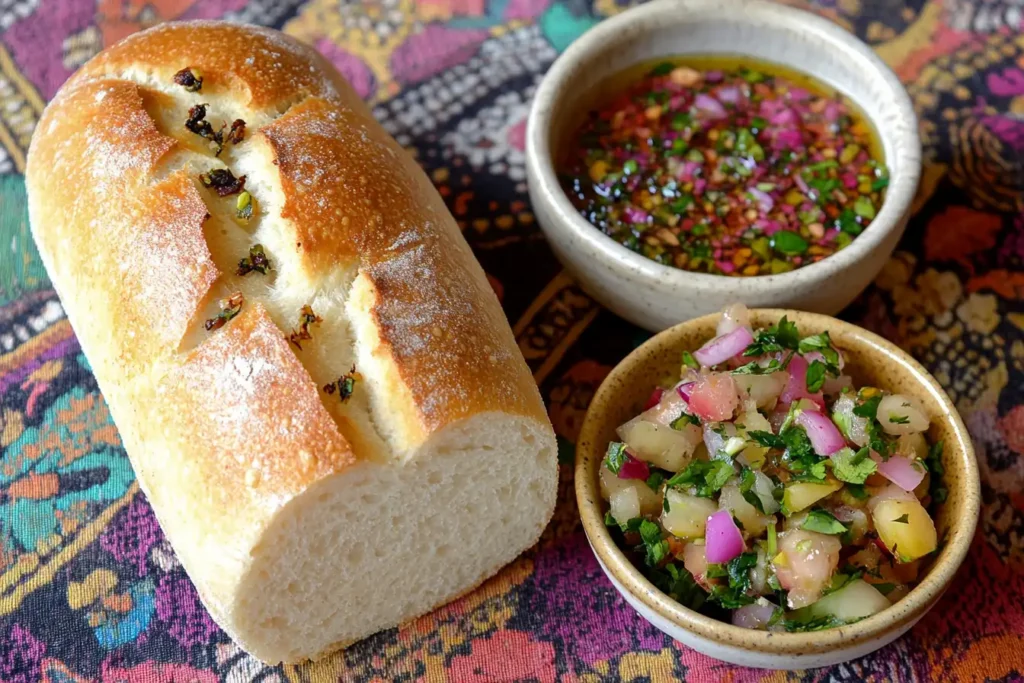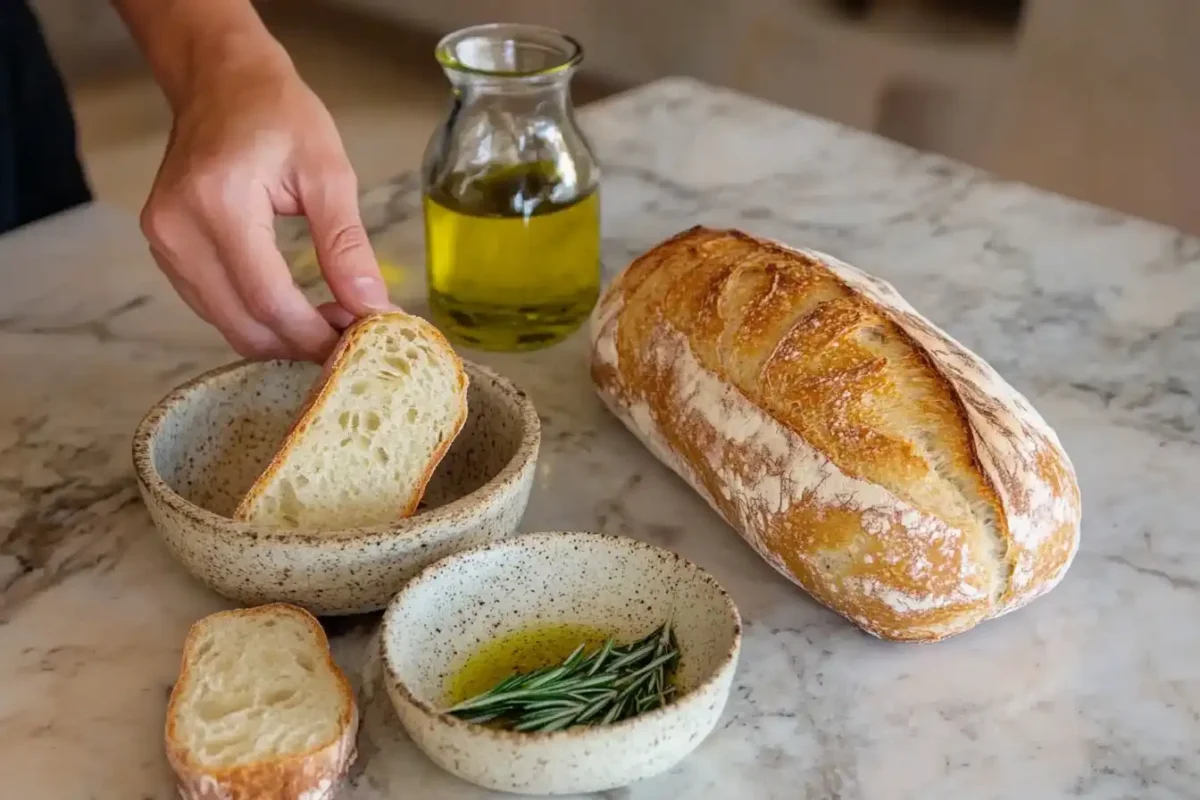Definition and Characteristics about long bread
Long bread refers to a type of bread distinguished by its characteristic elongated shape, which can vary significantly in style and texture. For instance, some loaves are narrow and crisp, while others are broader with a soft and tender crumb, catering to diverse culinary preferences. Furthermore, these breads often rely on simple, wholesome ingredients such as flour, water, yeast, and salt, yet their true uniqueness comes from the techniques and recipes used during preparation. From the crispy and golden crust of the iconic baguette to the light and airy crumb of a rustic ciabatta, each type boasts a distinct identity that reflects its cultural and regional origins. Additionally, the variety in textures and flavors makes long breads versatile staples in kitchens worldwide, suitable for both traditional and modern dishes. By focusing on both their form and preparation, bakers highlight the artistry that elevates these loaves into beloved culinary staples.
In many cultures, long breads symbolize simplicity, community, and tradition. The extended shape often makes them convenient for slicing, sharing, or preparing iconic dishes like sandwiches and bruschetta.
Cultural Significance
Bread, as a staple, carries profound meaning in various cultures. For instance, the baguette, known for its association with France, represents the elegance of French baking. In Italy, ciabatta emerged as a rustic loaf, embodying the country’s passion for hearty, flavorful cuisine. In Egypt, eish fino is an everyday necessity, often accompanying meals or serving as a pocket for fillings.
These breads transcend mere sustenance; they carry stories of regional pride, resourcefulness, and culinary artistry. They connect people, fostering a sense of shared heritage.
Types of Long Breads
French Baguette

History and Origin
The baguette is arguably the most iconic French bread, often synonymous with French culture itself. Its history dates back to the early 19th century, with its popularity skyrocketing in the 20th century due to laws restricting bakers’ working hours. The elongated shape made it faster to bake, while its crusty exterior and soft interior won over the hearts of bread lovers worldwide. Today, it is considered a staple in French households and an emblem of national pride.
Ingredients and Preparation
A traditional baguette consists of only four key ingredients: flour, water, yeast, and salt. What makes it special is the technique. Bakers carefully knead the dough, allow it to rise, and shape it into its signature elongated form. After a second rise, it is baked to perfection in a steam-injected oven, creating a golden crust and soft, airy crumb.
Variations
Though the traditional baguette is classic, variations abound. Some feature seeds like sesame or poppy, while others include whole grains for a heartier flavor. Mini baguettes, known as ficelles, are thinner and ideal for appetizers, while demi-baguettes serve as personal-sized portions.
Italian Ciabatta
History and Origin
Born in the Veneto region in the 1980s, ciabatta was created as Italy’s response to the French baguette. The word “ciabatta” means “slipper” in Italian, referencing its flat, broad shape. Its rustic, hearty nature quickly made it a favorite across Italy and beyond.
Ingredients and Preparation
| Nutrient | French Baguette | Italian Ciabatta | Egyptian Eish Fino |
|---|---|---|---|
| Calories | 270 kcal | 250 kcal | 290 kcal |
| Protein | 8 g | 7.5 g | 9 g |
| Carbohydrates | 57 g | 52 g | 60 g |
| Fat | 0.8 g | 3 g | 2.5 g |
| Fiber | 2.5 g | 2.3 g | 2 g |
| Sugar | 0.6 g | 0.5 g | 1 g |
| Sodium | 500 mg | 470 mg | 450 mg |
Ciabatta dough combines flour, water, yeast, and olive oil, which results in its signature open crumb and chewy texture. The high hydration level of the dough creates large air pockets during baking. After being shaped into loaves, it is baked until the crust turns crispy, offering a delightful contrast to the airy inside.
Variations long bread
Italian bakers often infuse ciabatta with herbs like rosemary or basil for added flavor. Some recipes use whole wheat or spelt flour, making the bread denser and nuttier. Ciabatta rolls, perfect for sandwiches, are another popular variation.
Egyptian Eish Fino

History and Origin long bread
Eish fino is a staple in Egyptian cuisine, its name translating to “fine bread.” Rooted in Egypt’s rich culinary traditions, this bread plays a vital role in everyday meals, particularly in urban areas. Unlike flatbreads like pita, eish fino is elongated, resembling a mini baguette but with a softer texture.
Ingredients and Preparation
Made with simple ingredients—flour, water, yeast, and sugar—eish fino is slightly sweet and softer than its European counterparts. The dough is shaped into smaller loaves, which rise before being baked to a light golden color.
Cultural Importance
In Egyptian households, eish fino is indispensable, used for sandwiches or served alongside dishes like falafel or grilled meats. Its affordability and versatility make it a cornerstone of the country’s culinary identity, cherished by all social classes.
Other Notable Long Breads
Pain de Campagne
Also known as French country bread, pain de campagne is a rustic loaf with a thick crust and dense crumb. Often baked with a mix of white, whole wheat, or rye flours, it is larger than the traditional baguette but retains an elongated shape. Its robust flavor makes it a favorite for hearty meals.
Grissini Breadsticks
Grissini, Italian breadsticks, are long and thin, offering a delightful crunch.Bakers from the Piedmont region originally flavored these breadsticks with olive oil, rosemary, or sesame seeds, making them a popular appetizer or snack.
Telera Bread
Telera bread is a Mexican classic, known for its oval, elongated shape. Its soft and slightly sweet texture makes it ideal for tortas (Mexican sandwiches). The dough includes milk and shortening, giving it a rich, tender crumb.
In the next section, we’ll explore the fascinating baking techniques that bring these long breads to life.
Baking Techniques and Recipes
Traditional Baking Methods
Oven Types
The foundation of traditional long bread baking undeniably lies in the choice of oven, which significantly impacts the bread’s texture and flavor. Historically, bakers relied on wood-fired ovens, as these ovens were known for their ability to produce high, consistent heat, which was essential for achieving the perfect bake.
Moreover, their even heat distribution created the crispy crusts and tender interiors that have become defining characteristics of long breads like baguettes and ciabattas. Additionally, the smoky aroma imparted by wood-fired ovens added a unique depth of flavor to the bread, enhancing its overall appeal.
These ovens were not just tools but also integral to the artistry of bread-making, connecting traditional methods with the exceptional quality of the final product.Steam ovens are another key tool, especially for baguettes, as the steam helps develop a shiny, golden crust. Bakers also favor stone ovens for their ability to retain and radiate heat, which ensures consistent baking.
Dough Preparation
Mastering dough preparation is essential for achieving the distinct texture of long breads. The process begins with carefully weighing ingredients to ensure precision. For traditional baguettes, the dough undergoes long fermentation, allowing flavors to develop. Ciabatta dough, on the other hand, is wetter, requiring delicate handling to retain air pockets. Kneading techniques vary too—French breads often require gentle stretching, while ciabatta benefits from minimal kneading to preserve its airy structure.
Modern Adaptations
Home Baking Tips
Baking long breads at home might sound intimidating, but with a few tips, anyone can recreate these loaves in their kitchen. Using a baking stone or steel is an excellent way to mimic the radiant heat of traditional ovens, ensuring consistent and even baking. Additionally, placing a tray of water in the oven generates steam, which is crucial for achieving a crispy and golden crust that defines long breads like baguettes and ciabattas. Furthermore, proper shaping plays a vital role in the final result. To achieve that characteristic elongated form, bakers should roll out the dough evenly and with care, as uneven shaping can impact both the texture and appearance of the loaf. By incorporating these techniques, you can create bakery-quality bread that not only looks professional but also tastes authentic. These steps bring traditional methods into modern kitchens, making the baking process both accessible and rewarding.
Ingredient Substitutions long bread
While traditional recipes call for basic ingredients, modern adaptations allow for creativity. Whole wheat or gluten-free flours can be used for a healthier twist. Sugar or honey may replace some flour in eish fino for extra sweetness. Olive oil can be swapped for butter in ciabatta for a lighter texture. With these substitutions, long breads can cater to dietary preferences while retaining their authentic charm.
Cultural and Culinary Uses for long bread
Role in Traditional Cuisines
French Cuisine
The baguette undeniably holds an esteemed place in French culture, and it represents far more than just a simple loaf of bread. In fact, it has become a cherished symbol of French culinary tradition and a quintessential part of everyday life. Typically, baguettes are served with nearly every meal, seamlessly accompanying a variety of dishes such as comforting soups, exquisite cheeses, and flavorful pâtés. Moreover, they play an essential role in French breakfasts, where slices of baguette are often slathered generously with creamy butter and sweet jam. Because of its versatility and cultural significance, the baguette has solidified its status as an iconic and indispensable element of French cuisine. Moreover, the bread’s elegant form and crusty texture make it the perfect vehicle for creating classic sandwiches like jambon-beurre (ham and butter).
Italian Cuisine
In Italy, ciabatta naturally complements the country’s robust and flavorful dishes, adding depth and texture to every meal it accompanies. Moreover, its chewy texture and large air pockets make it especially well-suited for soaking up rich, savory sauces, which enhances the overall dining experience. For example, it pairs perfectly with traditional dishes like pasta e fagioli (a hearty pasta and bean soup), where it acts as both a delicious side and an essential tool for savoring every drop of sauce. Additionally, ciabatta brings a rustic charm to the table, embodying the authentic simplicity and heartiness that defines Italian cuisine. These qualities have solidified its role as a cherished bread in Italian households and beyond. Ciabatta is also a staple in panini, Italian pressed sandwiches filled with cured meats, cheeses, and vegetables. Its rustic charm makes it a beloved choice for antipasto platters, paired with olive oil for dipping.
Egyptian Cuisine
In Egypt, eish fino is an everyday essential, and it plays a central role in both traditional meals and street food. Typically, it is used to make sandwiches filled with falafel, grilled meats, or even sweet fillings like date paste, showcasing its incredible versatility. Moreover, its soft and pliable texture makes it perfect for stuffing or tearing apart, which allows it to be dipped easily into rich, flavorful sauces. Beyond its practical culinary uses, eish fino is deeply woven into Egyptian street food culture, where it provides a quick, convenient, and satisfying option for busy locals who are always on the move. Consequently, it has become a bread that bridges tradition and modern convenience, cementing its place in daily life.
Popular Dishes Featuring Long Breads
Sandwiches and Subs
Long breads truly shine as the foundation for sandwiches and subs, as they offer the perfect balance of texture and flavor. For instance, the baguette serves as a crisp and hearty base for classics like banh mi (a Vietnamese sandwich bursting with vibrant flavors) and po’boys, a New Orleans favorite filled with fried seafood or roast beef. Furthermore, ciabatta is the go-to choice for gourmet sandwiches, as its airy crumb effortlessly soaks up flavorful dressings, enhancing the overall taste. Additionally, these breads elevate the sandwich experience by providing both structural integrity and the ability to complement diverse fillings. Meanwhile, eish fino is a popular choice for creating handheld meals packed with savory or sweet fillings.
Appetizers and Sides
Long breads also excel as appetizers or sides. Grissini breadsticks are perfect for dipping into marinara or pesto sauces, while sliced baguettes make ideal bases for bruschetta or crostini.In Mediterranean cuisine, chefs often serve toasted ciabatta alongside spreads like hummus or tzatziki. These versatile breads bring both texture and flavor to the table, enhancing every dish they accompany.
Frequently Asked Questions About Long Bread
The baguette originated in France, with its popularity rising in the 19th and 20th centuries. While its precise origins remain debated, many credit its development to the introduction of steam ovens, which helped create its signature crust. Additionally, laws limiting bakers’ working hours influenced its shape, as the thinner loaves baked faster than traditional bread.
While both are long breads, ciabatta and baguette have distinct differences. Ciabatta is softer, with a chewy texture and large, irregular air pockets due to its higher hydration dough. It’s flatter and broader, resembling a slipper. In contrast, the baguette has a crisp crust and a finer, uniform crumb, with a more cylindrical and slender shape.
Eish fino is a versatile bread in Egyptian cuisine.People commonly use it to make sandwiches filled with falafel, kebabs, or even sweet spreads like honey. Its soft, pliable texture makes it ideal for stuffing or tearing to dip into flavorful sauces. It’s a street food staple, deeply embedded in daily life.
Yes! Baking long breads at home is possible with the right techniques. Using a baking stone or steel, creating steam in the oven, and following specific recipes for each bread type can help recreate their textures and flavors. It’s an art, but with practice, it becomes an achievable skill.
Variations include seeded baguettes, rosemary-infused ciabatta, and flavored breadsticks like grissini with sesame or garlic. Regional adaptations, such as pain de campagne and telera bread, also offer unique spins on the classic elongated shape.
To keep long breads fresh, store them in a paper bag at room temperature for up to two days. For longer storage, wrap them in foil or plastic and freeze them. Reheating in the oven can revive their crusty exterior and soft interior.
Conclusion To Long Bread
Long breads, with their distinct shapes and rich histories, are more than just a staple—they are a testament to cultural ingenuity and culinary artistry. From the iconic baguette of France to Italy’s rustic ciabatta and Egypt’s essential eish fino, each type offers a glimpse into its region’s traditions and flavors. These breads not only nourish but also bring people together, forming the basis of countless meals and cherished recipes around the world.
Whether baked traditionally in wood-fired ovens or adapted for modern kitchens, long breads continue to evolve while retaining their timeless appeal. They effortlessly lend themselves to a wide array of uses, ranging from sandwiches and appetizers to hearty accompaniments for soups and stews. Furthermore, their adaptability makes them indispensable in various cuisines, whether as a base for savory dishes or as a side that enhances the dining experience. By exploring their origins, mastering their baking techniques, and understanding their cultural significance, we not only deepen our appreciation for these versatile loaves but also gain insight into the culinary traditions they represent. Consequently, these breads become more than just food—they embody history, creativity, and the power to bring people together.
So, whether you’re crafting a homemade baguette, savoring a ciabatta sandwich, or enjoying eish fino alongside a flavorful dish, long breads remind us of the simple joys of sharing food and stories. Explore their varieties, experiment with recipes, and savor every bite—because these elongated loaves are as delightful as they are enduring.

